With millions of people entrusting their entrepreneurial dreams to Shopify, understanding the platform’s statistics is important. From sales data to user demographics, these figures provide a panoramic view of the platform’s influence and its direction in the ever-evolving digital marketplace. Dive into our thorough Shopify statistics guide to learn about the details that affect the world of online commerce.

Top Shopify Store Statistics
By June 2023, Shopify’s global presence was undeniable, and according to statistics, there are over 4.3 million stores on Shopify.
- A closer look at the distribution reveals the fashion industry’s preference for Shopify; approximately a quarter of these online stores were dedicated to apparel retailing. However, Shopify’s versatility stretches beyond just clothing.
- The home and garden niche also found its digital footing on this platform, boasting around 221,000 dedicated online storefronts.
- Not far behind, the beauty and fitness sectors combined their allure and functionality, marking their spot with approximately 187,000 online boutiques. This distribution underscores Shopify’s adaptability and appeal to a broad spectrum of eCommerce entrepreneurs.
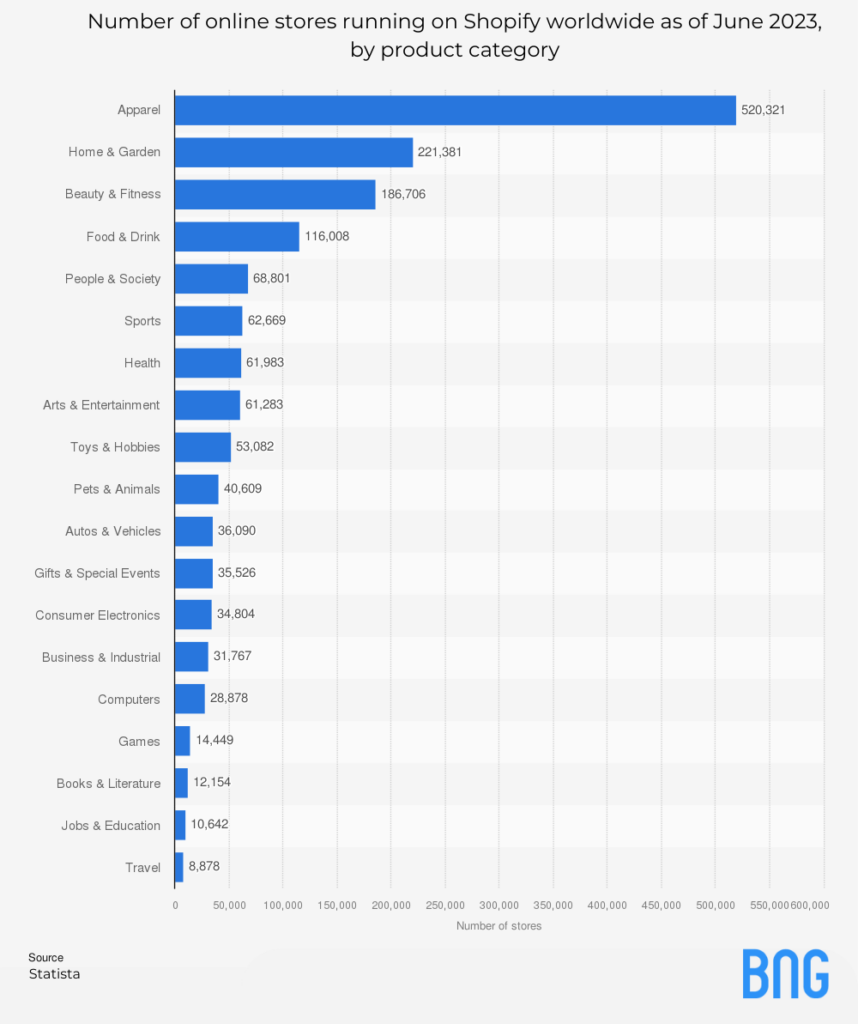
Let’s take a look at the total number of active online stores on Shopify in this table:
| Product Category | Number of Online Stores |
|---|---|
| Apparel | 520,321 |
| Home & Garden | 221,381 |
| Beauty & Fitness | 186,706 |
| Food & Drink | 116,008 |
| People & Society | 68,801 |
| Sports | 62,669 |
| Health | 61,983 |
| Arts & Entertainment | 61,283 |
| Toys & Hobbies | 53,082 |
| Pets & Animals | 40,609 |
| Autos & Vehicles | 36,090 |
| Gifts & Special Events | 35,526 |
| Consumer Electronics | 34,804 |
| Business & Industrial | 31,767 |
| Computers | 28,878 |
| Games | 14,449 |
| Books & Literature | 12,154 |
| Jobs & Education | 10,642 |
| Travel | 8,878 |
MORE: How much does a Shopify store cost?
Shopify Market Share Statistics
Who are Shopify’s competitors?
With approximately 28% of all websites harnessing eCommerce technologies choosing Shopify, its presence is undeniably influential. While Shopify leads the pack, the market is not without competition.
Platforms like Wix Stores, WooCommerce Checkout, and Squarespace Add to Cart are also making notable inroads, each securing a market share of 14% or more. The diversity of choices underscored the dynamic nature of the eCommerce software market in the U.S., with multiple platforms vying for dominance.
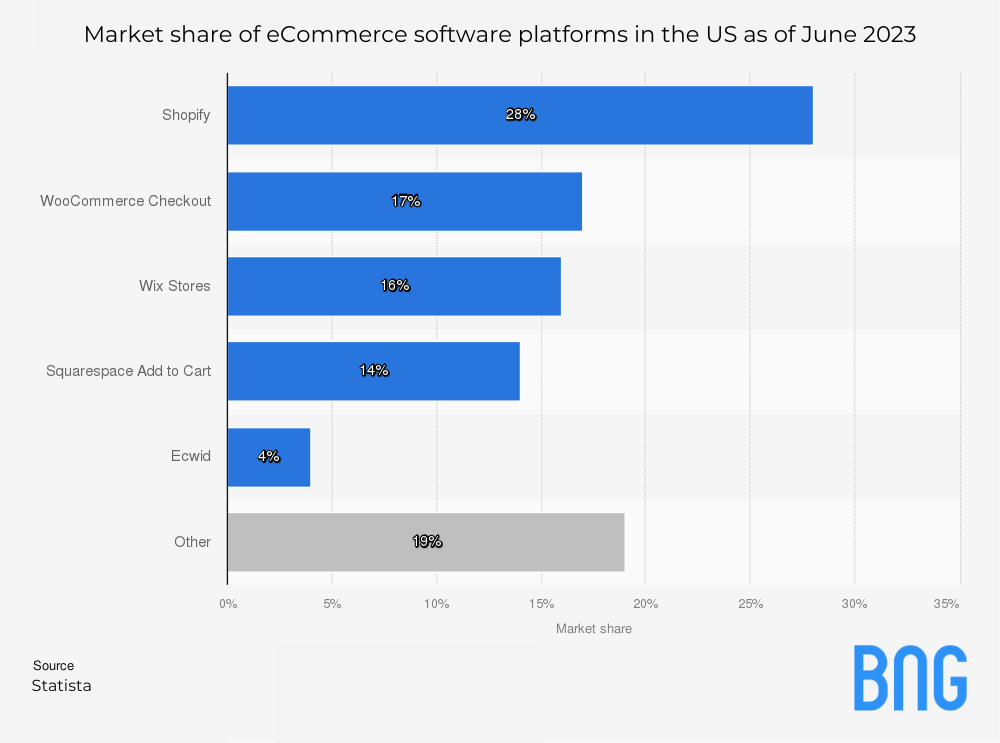
MORE: How to Start a Business
Shopify Revenue Statistics
In the financial year of 2022, Shopify reported impressive revenues of approximately 5.6 billion U.S. dollars, signaling its exponential growth in the eCommerce industry. Tracing back to 2015, the company’s financial trajectory paints a picture of consistent and remarkable expansion. The following are the annual revenue figures:
- 2015 saw earnings of 205.23 million USD.
- In 2016, the figure nearly doubled to 389.33 million USD.
- By 2017, revenue had risen to 673.3 million USD.
- 2018 witnessed the company crossing the billion-dollar mark with earnings of 1073.23 million USD.
- 2019 continued the upward trend with 1578.17 million USD in revenue.
- 2020 experienced a surge, with earnings reaching 2929.49 million USD.
- The growth trajectory persisted in 2021, amassing a revenue of 4611.86 million USD.
This eight-year overview showcases the robust financial health of Shopify and its transformative journey, increasing its revenue by over four billion dollars from 2015 to 2022.
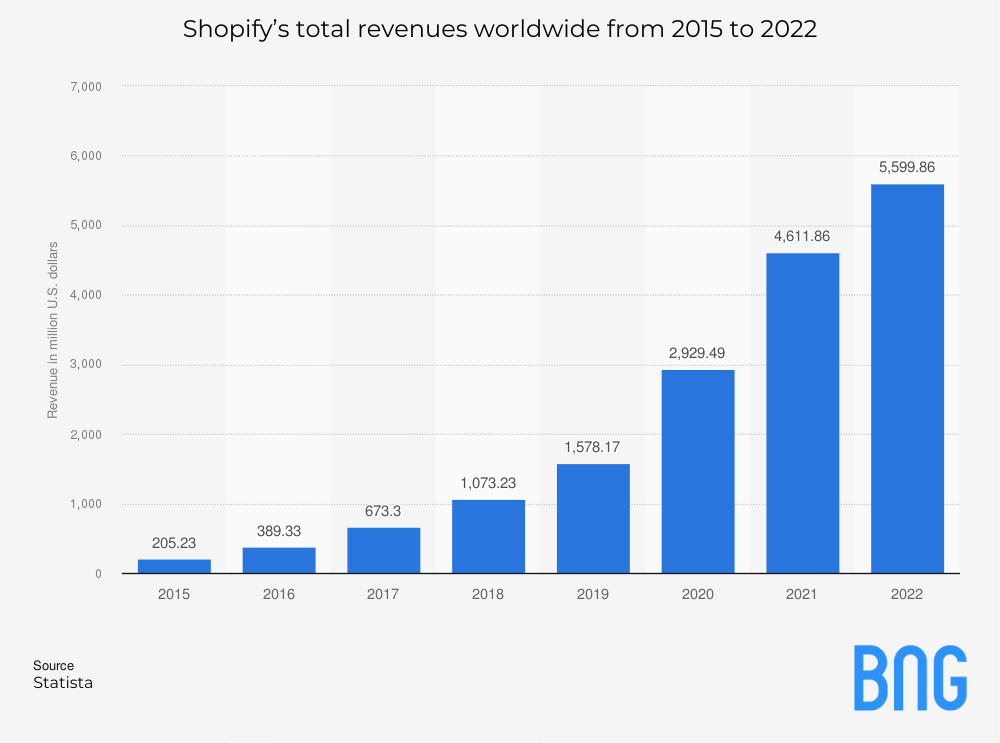
MORE: Shopify vs Shopify Plus
Shopify Net Income/Loss
During the fiscal year of 2022, Shopify reported a significant net income loss, amounting to around 3.5 billion U.S. dollars. This comes in stark contrast to the company’s performance in 2020 when, for the first time, Shopify celebrated a positive net income, marking a departure from its earlier trend of net losses. Remarkably, from that pivotal year to the next, the company’s net income witnessed a nearly tenfold increase, emphasizing the dynamic shifts in its financial landscape.
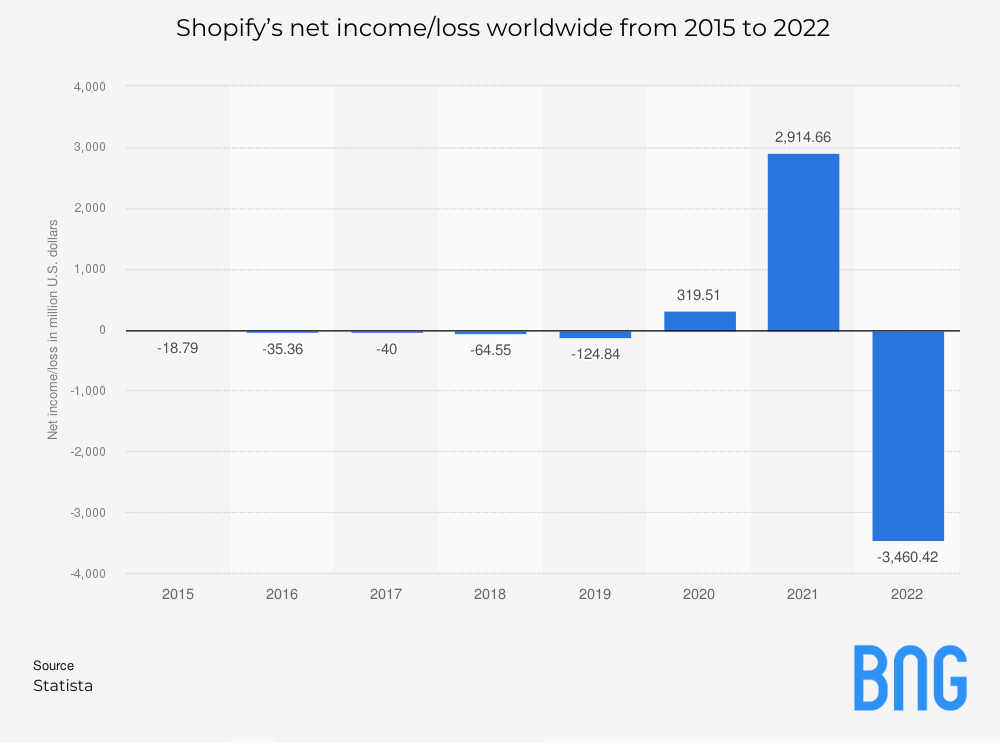
MORE: How to Open a Shopify Store
How Many People Buy from Shopify Store?
In the first three months of 2023, Shopify’s gross merchandise volume (GMV) impressively touched close to 50 billion U.S. dollars. This, however, was slightly overshadowed by its stellar performance in the last quarter of 2022 when the GMV peaked at an astounding 61 billion U.S. dollars, marking a three-year high for the company.
As clarified by Shopify, the GMV provides a snapshot of the total value of transactions processed through its platform. This encompasses orders made via its various apps and channels that engage in a revenue-sharing model. Furthermore, the GMV takes into account the full order value, inclusive of aspects like shipping and handling, duty, and value-added taxes, while also subtracting any refunds.
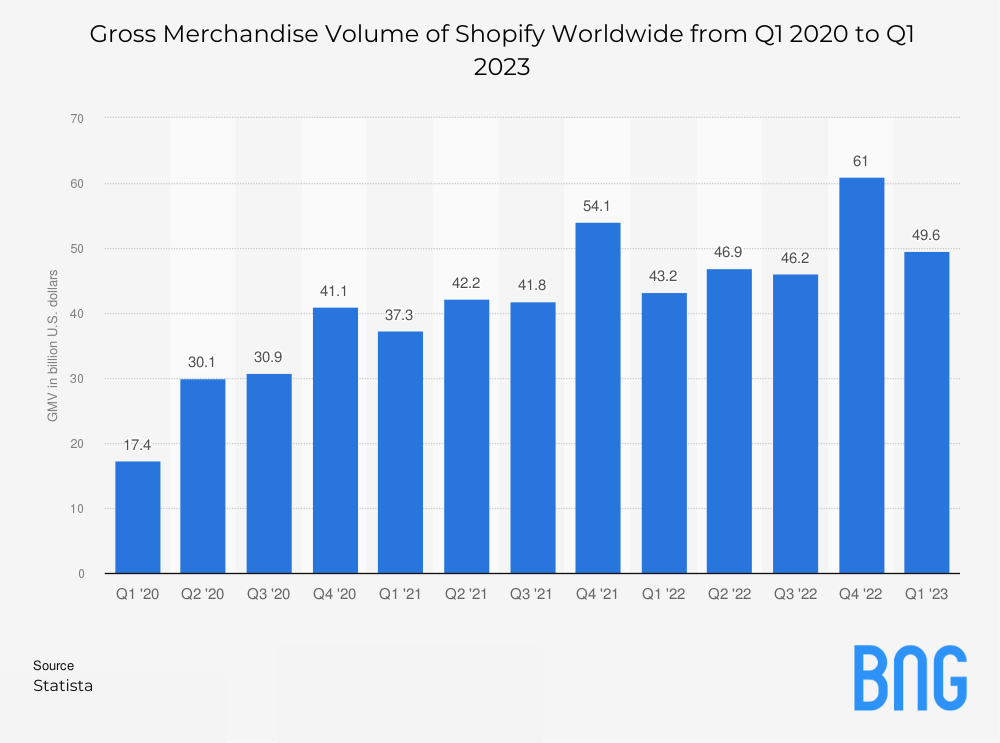
Here’s a closer look at the GMV of Shopify worldwide:
| Quarter/Year | GMV in billion USD |
|---|---|
| Q1 2020 | 17.4 |
| Q2 2020 | 30.1 |
| Q3 2020 | 30.9 |
| Q4 2020 | 41.1 |
| Q1 2021 | 37.3 |
| Q2 2021 | 42.2 |
| Q3 2021 | 41.8 |
| Q4 2021 | 54.1 |
| Q1 2022 | 43.2 |
| Q2 2022 | 46.9 |
| Q3 2022 | 46.2 |
| Q4 2022 | 61 |
| Q1 2023 | 49.6 |
MORE: Shopify Branding
How Many Shopify Stores Are There?
The United States has nearly one million online stores, more than any other country. The United Kingdom, Canada, and Australia are close behind, each contributing to the global tally with upwards of 100,000 stores apiece. As for the global footprint of Shopify, Italy and the Netherlands also made a notable presence, finding themselves among the top ten countries with a significant number of Shopify online stores as of July 2023.
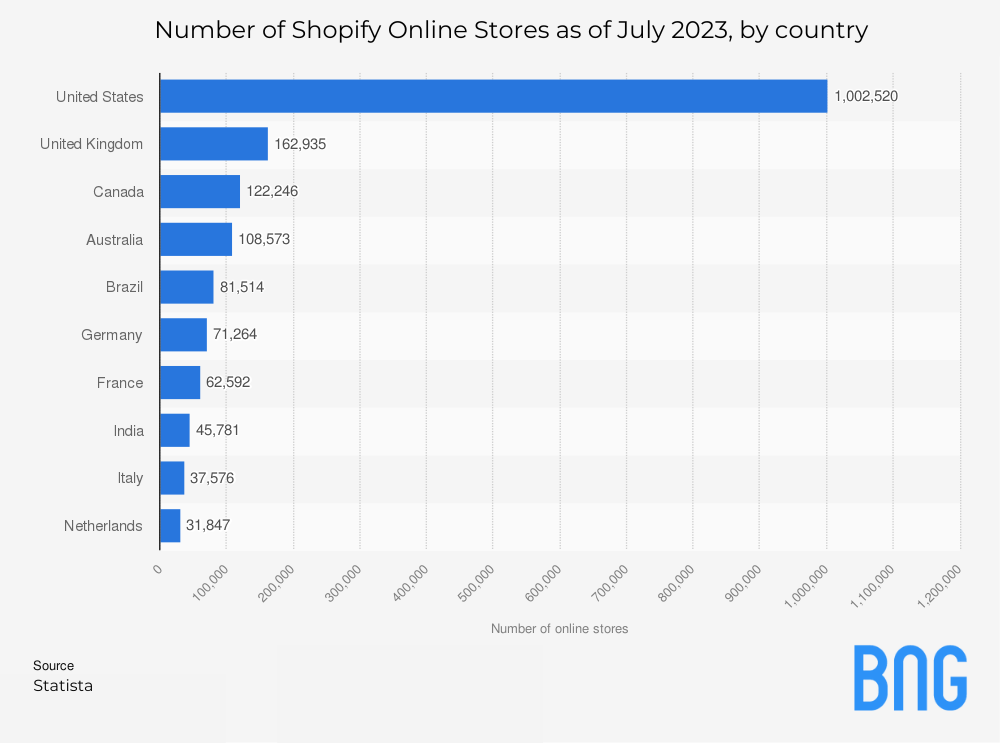
Are you thinking of opening your own Shopify store but can’t come up with the perfect name? Our Business Name Generator is here to help you. Simply input a few words that you would like to be associated with your business, and our platform’s AI will come up with thousands of names that you can pick and register right away.
Number of Shopify Online Stores by Number of Products Sold
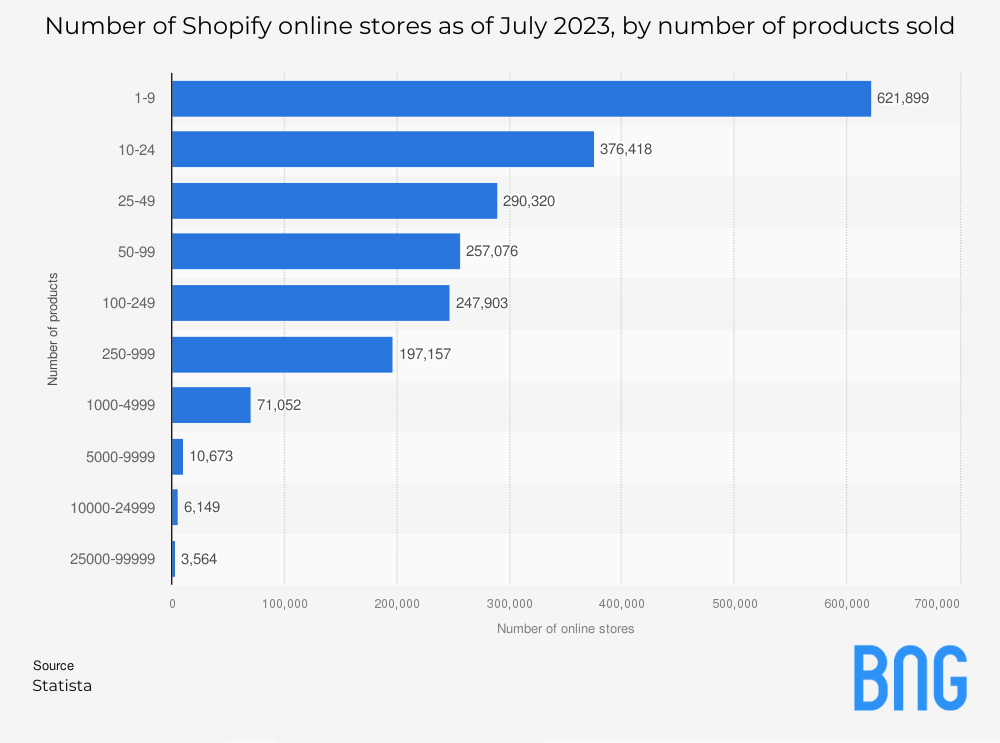
- As of July 2023, intriguing patterns emerged regarding the interplay between the quantity of Shopify online stores and their respective product listings. A clear inverse relationship was observed: the greater the number of Shopify stores, the fewer products they generally had on offer.
- When it comes to specifics, a staggering 621,899 stores listed fewer than ten products. This trend showed as stores listed between ten and 24 products, with 376,418 such entities.
- The numbers continued to diminish as the product range broadened: 290,320 stores offered between 25 and 49 products, while 257,076 showcased a range of 50 to 99 items.
- For stores with a more extensive inventory, 247,903 fell in the 100-249 product bracket. There was a significant drop as we moved up the product listing ladder:
- 197,157 stores offered between 250 and 999 products; 71,052 had a range of 1,000 to 4,999; only 10,673 boasted 5,000 to 9,999 products.
- The numbers dwindled even further for those with expansive catalogs: 6,149 stores featured 10,000 to 24,999 products, and a mere 3,564 had an impressive 25,000 to 99,999 items.
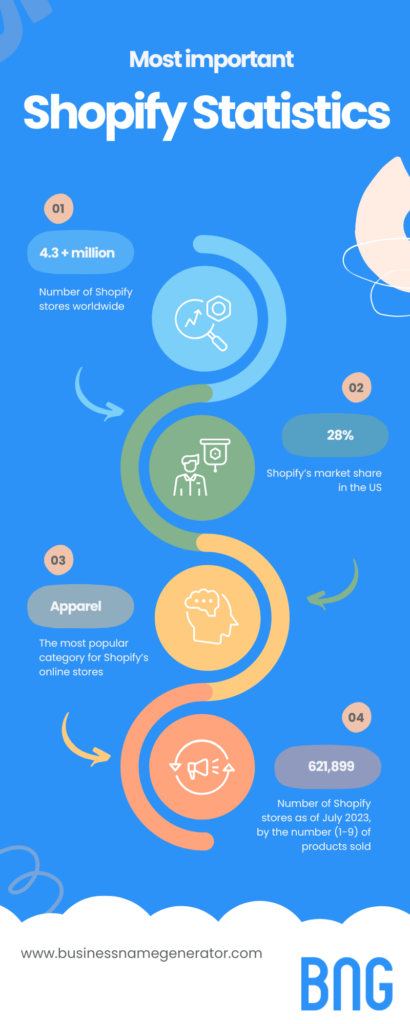
Takeaway Points
Shopify’s influence in the eCommerce domain is undeniably evident through its impressive metrics. With millions of live stores globally and a significant concentration in countries like the United States. The data reveals intriguing patterns, such as the inverse relationship between the number of stores and the quantity of products they offer.
Furthermore, despite facing challenges, Shopify’s gross merchandise volume and revenue numbers speak volumes about its predominant position in the market. Examining these statistics offers a comprehensive view of Shopify’s impact, growth trajectory, and the evolving trends within the eCommerce landscape.